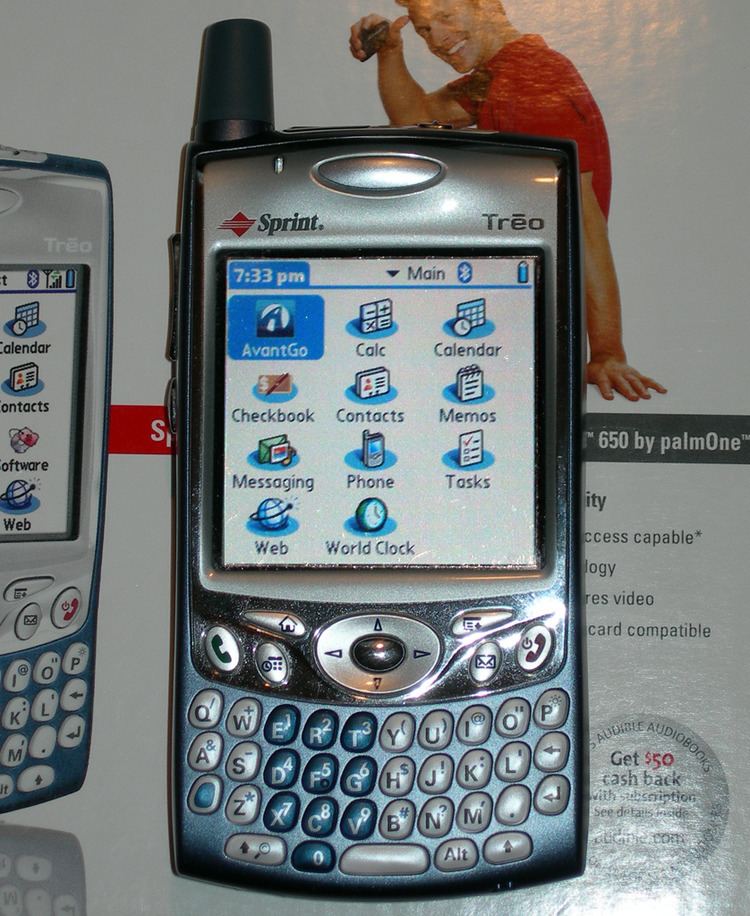Retail availability November 20042008 Operating system | Type Smartphone Media MMC, SD | |
 | ||
CPU Intel PXA270 312 MHz processor with Intel XScale technology | ||
The Palm Treo 650 was a Palm OS-based smartphone, the successor to Palm's Treo 600. It began shipping in November 2004, and was discontinued in 2008.
Contents
Carriers
The following GSM and CDMA2000 mobile phone operators currently or previously offered a custom-branded (OEM) version of the Treo 650:
In release order
As seen on Palm's support page, these carriers are the sole providers of support for the OEM phones.
Other carriers
Nextel (USA) and other iDEN providers are not compatible with the Treo 650, as this technology has not been integrated into the Treo platform. T-Mobile (USA) and other GSM carriers not listed above are compatible with the unlocked version of the GSM Treo 650.
NVFS controversy
At the time of its release, a significant number of users experienced problems with Palm's new Non-Volatile File System, or NVFS, based on the FAT filesystem. Compared to the Treo 600, the previous version of the Treo, the Treo 650 used more memory per file as the FAT filesystem rounded file sizes to the next highest 512-byte multiple. Because of the larger file sizes, some users upgrading to the Treo 650 from the Treo 600 were unable to fit the contents of their old device into the same amount of memory on the new device.
To remedy the initial complaints, Palm offered a free 128 MB SD flash card to Treo 650 users. Later ROM updates have resolved many of the performance, instability and storage inefficiency issues.
Other main concerns surrounding the Treo 650 (during its initial release period) were as follows:
Firmware solutions
On March 22, 2005, palmOne released the first ROM/Firmware Update (v1.12) for Sprint-branded phones which alleviated the NVFS inefficiency, random resets and the microphone problems. This was followed by a second firmware update on June 16, 2005. The Unlocked GSM Firmware Upgrade (v1.13) was also released on the day of the second Sprint Treo 650 firmware update which also addresses the problems first fixed with the first Sprint Treo 650 firmware update. The Rogers Wireless Treo 650 Firmware Update was quietly posted at the Rogers Wireless Treo 650 support site, and like the Unlocked GSM Firmware Update, fixes the main concerns during the initial release period. The initial release of the Verizon Wireless Treo 650 and the Earthlink Wireless Treo 650 already has the main concerns assessed, including the NVFS Memory System fix. On July 19, 2005 the Verizon Wireless firmware update was released. On July 25, 2005, Cingular released firmware version 1.15, and updated to 1.17 on November 21. Unlocked GSM 1.20 was released Mar 2006.
The latest (and last) GSM firmware revision is 01.71 (released 2006), with 01.31 released late 2005.
Treo 650 users are encouraged to deploy the latest version of the Treo 650 firmware available for their radio type (GSM or CDMA2000) and carrier branding.
Treo Ace
The Treo Ace was the rumored code name for PalmOne's Treo 650 smartphone introduced at the October 2004 CTIA Conference in San Francisco. The rumors for this product began on June 27, 2004, when TreoCentral posted detailed specifications and mockup drawings for the product. That article started the flow of hyped demand and interest for the Treo's launch that fall
The current firmware updates for the device contain a directory by the name of Ace_Update, confirming the original internal code name. A string inside the Bluetooth driver file indicates that another internal code name may have been "Ace Ventura", a reference to the movie of the same name.
Linux
The Treo 650 can boot Linux using a SD card and the cocoboot application.
Successor products
The CDMA2000 version was superseded by newer models such as the Treo 700p, Treo 755p, Treo 700w, Treo 700wx and Treo Pro, while the GSM version was superseded by the Treo 680, Treo 750v and Treo Pro.
